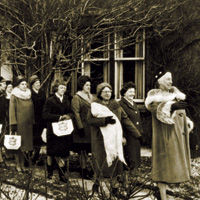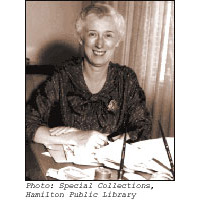In 1949, desperate to find a cure and protect their children from polio, mothers across Canada joined in a North America-wide fundraising effort, going door to door in their own neighbourhoods to collect dimes.
The sheer scope of the campaign led entertainer Eddie Cantor to suggest the name "March of Dimes", based on the song "Brother can you spare a dime?" produced during the Great Depression.
By 1951 the Canadian Foundation for Poliomyelitis was established and granted use of the name "Ontario March of Dimes."
In 1955, after the polio vaccine created by Dr. Jonas Salk proved effective in limited test trials, laboratories rushed to manufacture the vaccine, including Connaught Laboratories (now Sanofi Pasteur) in Toronto, Canada.
With the threat of polio greatly diminished, the March of Dimes in Canada began funding centres for people who had already contracted the disease, with early programs focused mostly on rehabilitation and job training.
By the early 1960s, the organization had grown in both size and mandate, shifting considerably to serve the broader needs of all adults with physical disabilities. In Ontario the legal name of the organization was changed to the Rehabilitation Foundation for the Disabled.
In 2006, Ontario March of Dimes registered the operating name of March of Dimes Canada. Today, March of Dimes is dedicated to helping children and adults across Canada to lead more independent lives.
Marching Mothers®

There is probably no other Canadian phenomenon that exemplified the true spirit of volunteerism more than the Marching Mothers® campaigns of the 1950s and 1960s.
Desperate to find a cure for polio, a highly contagious, disabling and sometimes fatal disease, mothers across Canada joined a North America-wide fundraising drive towards research.
Known as the Marching Mothers®, these dedicated volunteers went door-to-door in their neighbourhoods, collecting donations for the March of Dimes.
From celebrity endorsements, to local media campaigns, to the ringing of fire alarm bells from the centre of town, many in their communities got involved.
Women canvassed their neighbours carrying pickle jars or canvassing kits. Homes welcoming Marching Mothers® turned on their porch lights to signal their support.
Over the years, this simple, community-based process raised millions of dollars for polio research and rehabilitation. It supported the research of Dr. Jonas Salk, whose polio vaccine was released in 1955, putting an end to the epidemics.
But long after the vaccine's discovery, women and men continued the annual marches. The funds initially assisted polio survivors, but today they support a wide range of vital services for adults and children with physical disabilities across Ontario.
Ellen Fairclough: Chief Marching Mother

2011 marks the 60th anniversary of March of Dimes in Canada. The charity was established in 1951 to help eradicate the threat of polio, an often disabling and sometimes fatal virus. Mothers, determined to find a vaccine that would protect their children began a campaign, going door-to-door to collect money for research, one dime at a time. These women were known as the Marching Mothers. Leading the way, with the title of "Chief Marching Mother" was the Right Honourable Ellen Louks Fairclough, PC, CC, OOnt. Ms. Fairclough passed away in 2004 at 99 years old. In tribute to her enormous contributions to the organization, a March of Dimes giving society is named in her honour.
The Right Honourable Fairclough is a Canadian legend, a champion of women’s rights and was, among her many ‘firsts’, the first female member of Cabinet and the first female Acting Prime Minister. But in 1947, her most important role was mother, when her 15 year old son Howard contracted polio in the family’s hometown of Hamilton, Ontario.
Joan Heels - Ms. Fairclough’s niece and a monthly donor to March of Dimes, remembers the summer her cousin Howard took ill.
"I had been keeping Howard company, because he hadn’t been feeling well, and when he went into the hospital the next day with polio – I had to go into quarantine for two weeks," she says.
"Howard had been told he would likely never walk again, but he surprised his doctors by walking out of the hospital on two canes. Only my aunt Ellen wasn’t surprised, she told Howard (a wonderful musician) that she knew he’d find the strength, so he could keep playing the organ," she continues.
After Howard contracted polio, the Right Honourable Fairclough became an immediate activist, advocating for better conditions for all of Hamilton’s polio patients. Up to that point, those with polio were kept separated from other patients in small, hot, cramped rooms. Ms. Fairclough campaigned to have them moved into a nearby military hospital that wasn’t being used. She was successful, improving the condition of polio patients dramatically.
Ms. Fairclough also became involved with March of Dimes, first joining the Provincial Board in 1956 and then becoming Chief Marching Mother the following year in 1957. She can be seen in an iconic photo, leading a group of women as they go door-to-door.
Howard was eventually discharged from the hospital, and his father Gordon, along with Ms. Fairclough, worked diligently to help him strengthen his muscles, allowing him to continue playing the music he loved. Howard suffered from fatigue for most of his life, and began experiencing the symptoms of post-polio syndrome in the 1980s. He passed away in 1986 in part due to polio.
Howard and his mother’s legacy had a huge impact. It was due to the support of March of Dimes’ funding – raised by the Marching Mothers, that resulted in the needed vaccine’s discovery in 1955. It is because of the Right Honourable Fairclough, and women like her, that millions of children were spared the devastating effects of polio.
Then, in 2003, Ontario March of Dimes established
The Ellen Fairclough Society, to honour her leadership and recognize those who carry on her work helping people with physical disabilities.
With the discovery of the vaccine, March of Dimes then turned its mission from "cure" to "care" by providing support, first to polio survivors, then expanding its mandate to provide a wide range of much-needed services to children and adults with any type of disability.
March of Dimes now serves over 50,000 Canadians annually, but hasn’t forgotten its roots. Services continue for polio survivors, who are now living with the effects of post-polio syndrome.
